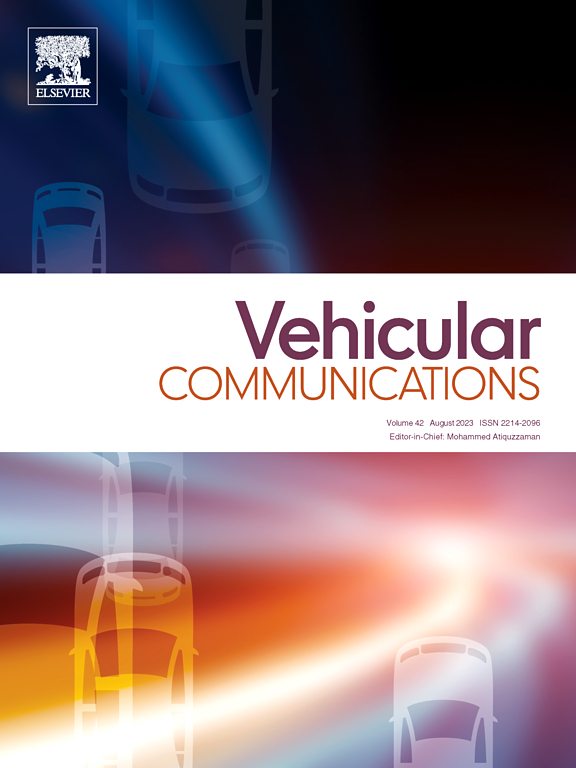QRCF: A new Q-learning-based routing approach using a smart cylindrical filtering system in flying ad hoc networks
IF 6.5
2区 计算机科学
Q1 TELECOMMUNICATIONS
引用次数: 0
Abstract
To ensure reliable data transmission in flying ad hoc networks (FANETs), efficient routing protocols are necessary to establish communication paths in FANETs. Recently, reinforcement learning (RL), particularly Q-learning, has become a promising approach for overcoming challenges faced by traditional routing protocols due to its capacity for autonomous adaptation and self-learning. This study presents a Q-learning-based routing strategy, enhanced by an innovative cylindrical filtering technique, named QRCF in FANETs. In QRCF, the dissemination interval of hello packets is adaptively adjusted based on the connection status of nearby UAVs. Then, this routing process leverages Q-learning to discover reliable and stable routes, using a state set refined by the cylindrical filtering technique to accelerate the search for the optimal path in the network. Afterward, the reward value is computed using metrics such as relative speed, connection time, residual energy, and movement path. Finally, QRCF is deployed in the network simulator 2 (NS2), and its performance is evaluated against three routing schemes, QRF, QFAN, and QTAR. These evaluations are presented based on the number of UAVs and their speed. In general, when changing the number of nodes, QRCF improves energy usage (about 5.01%), data delivery ratio (approximately 1.20%), delay (17.71%), and network longevity (about 3.21%). However, it has a higher overhead (approximately 10.91%) than QRF. Moreover, when changing the speed of UAVs in the network, QRCF improves energy usage (about 4.94%), data delivery ratio (approximately 2.36%), delay (about 17.5%), and network lifetime (approximately 8.75%). However, it increases routing overhead (approximately 15.47%) in comparison with QRF.
QRCF:一种新的基于q学习的路由方法,在飞行自组织网络中使用智能圆柱滤波系统
为了保证飞行自组织网络(fanet)中数据的可靠传输,需要有效的路由协议来建立飞自组织网络中的通信路径。最近,强化学习(RL),特别是q学习,由于其自主适应和自学习的能力,已经成为克服传统路由协议面临的挑战的一种很有前途的方法。本研究提出了一种基于q学习的路由策略,并通过一种创新的圆柱形过滤技术(在fanet中称为QRCF)进行增强。在QRCF中,hello报文的传播间隔根据附近无人机的连接状态自适应调整。然后,该路由过程利用Q-learning来发现可靠且稳定的路由,使用圆柱形过滤技术改进的状态集来加速对网络中最优路径的搜索。然后,使用诸如相对速度、连接时间、剩余能量和移动路径等指标计算奖励值。最后,在网络模拟器2 (NS2)中部署了QRCF,并对QRF、QFAN和QTAR三种路由方案进行了性能评估。这些评估是根据无人机的数量和速度提出的。总的来说,在改变节点数量的情况下,QRCF可以提高能耗(约5.01%)、数据传输率(约1.20%)、时延(约17.71%)和网络寿命(约3.21%)。然而,它比QRF有更高的开销(大约10.91%)。此外,当改变网络中无人机的速度时,QRCF提高了能量使用(约4.94%),数据传输率(约2.36%),延迟(约17.5%)和网络寿命(约8.75%)。然而,与QRF相比,它增加了路由开销(大约15.47%)。
本文章由计算机程序翻译,如有差异,请以英文原文为准。
求助全文
约1分钟内获得全文
求助全文
来源期刊

Vehicular Communications
Engineering-Electrical and Electronic Engineering
CiteScore
12.70
自引率
10.40%
发文量
88
审稿时长
62 days
期刊介绍:
Vehicular communications is a growing area of communications between vehicles and including roadside communication infrastructure. Advances in wireless communications are making possible sharing of information through real time communications between vehicles and infrastructure. This has led to applications to increase safety of vehicles and communication between passengers and the Internet. Standardization efforts on vehicular communication are also underway to make vehicular transportation safer, greener and easier.
The aim of the journal is to publish high quality peer–reviewed papers in the area of vehicular communications. The scope encompasses all types of communications involving vehicles, including vehicle–to–vehicle and vehicle–to–infrastructure. The scope includes (but not limited to) the following topics related to vehicular communications:
Vehicle to vehicle and vehicle to infrastructure communications
Channel modelling, modulating and coding
Congestion Control and scalability issues
Protocol design, testing and verification
Routing in vehicular networks
Security issues and countermeasures
Deployment and field testing
Reducing energy consumption and enhancing safety of vehicles
Wireless in–car networks
Data collection and dissemination methods
Mobility and handover issues
Safety and driver assistance applications
UAV
Underwater communications
Autonomous cooperative driving
Social networks
Internet of vehicles
Standardization of protocols.
 求助内容:
求助内容: 应助结果提醒方式:
应助结果提醒方式:


